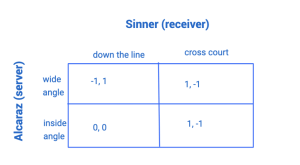Game Theory Through Tennis
The US Open has gripped the nation the past two weeks, with millions of people tuning in to watch the annual tennis tournament both in person and on TV. While most people merely watch the matches for entertainment, few are aware of the split second decisions that the players must make, depending upon their opponents actions. As Joel Wiles describes, there is a clear and present use of game theory, albeit quick, during the sport of tennis. Wiles investigates the action and reaction patterns of tennis, specifically regarding the placement of the serve and the return.
In the game of tennis, there are different strategies depending on if the player is serving or receiving. Each game, players take turns serving and receiving serve. The server starts the point, serving to the opposite box on the opponent’s side. The server can place their serve either using the wide angle, or the inside angle of the box. On the other hand, the server’s opponent receives the ball and can return either in the cross court or down the line direction. This scenario is seen in “Tennis Tournament Game Theory”, where the match between Rafael Nadal and Roger Federer at the 2009 Australian Open is analyzed through the Prisoner’s Dilemma. Although this example is extremely insightful, I found it to be a rare occurrence, as only 10% of the world’s tennis players are lefty. Therefore, this blogpost will focus on analyzing more prevalent examples of the Prisoner’s Dilemma seen in tennis.
The first example to be analyzed is when both the server and receiver are righty, and their favorite shot is the forehand. This is seen during the 2022 US Open, where Carlos Alcaraz played against Casper Rudd in the finals. Both players preferred their forehand, and assume that Alcaraz is the server and Rudd is the receiver. The Nash Equilibrium is seen below:
If Alacarz serves the wide angle and Rudd returns the ball down the line, Rudd takes the advantage, leaving the score at -1, 1 . If Alcaraz serves the wide angle and Rudd returns cross court, Alcaraz takes the advanatge, earning 1 point while Rudd loses 1 point. If Alcaraz serves the inside angle and Rudd returns down the line, no player has the advantage, and the score is 0, 0. If Alcaraz serves the inside angle and Rudd returns cross court, Alcaraz has the advantage and the score is 1, -1.
As seen in the diagram, the dominant strategy for Sinner is to hit the return down the line. The best strategy for Alcaraz is to serve with the inside angle. In terms of tennis terms, this strategy makes sense, as the inside serve is to Sinner’s weaker backhand. This scenario can be seen on all levels, as the majority of players are right handed and prefer their forehand, as Wiles describes.
On the other hand, a different scenario may arise, such as a situation where the players prefer their backhand to their forehand, which is often seen in womens tennis, according to Wiles. Below, we examine the match between two righties, Emma Raducanu and Alize Cornet, which took place at the 2022 US Open. Both players openly prefer their backhand.
If Raducanu serves the wide angle and Cornet returns the ball down the line, Raducanu takes the advantage, leaving the score at 1, -1 . If Raducanu serves the wide angle and Cornet returns cross court, no player has the advantage, and the score is 0, 0. If Raducanu serves the inside angle and Cornet returns down the line, Raducanu takes the advanatge, earning 1 point while Cornet loses 1 point. If Raducanu serves the inside angle and Cornet returns cross court, Raducanu takes the advanatge, earning 1 point while Cornet loses 1 point.
As seen in the diagram, the dominant strategy for Cornet is to return cross court, as she has an unfavorable outcome each time she returns down the line. Similarly, the wide angle is the best strategy for Raducanu, as she is essentially serving to the weaker side of her opponent.
This is interesting to compare the Prisoner’s Dilemma between the women’s match and the men’s match, as the strategies are different. Evidently, the strategy seen in men’s and women’s tennis matches are different. Looking at the serve and return strategy for tennis through the lens of game theory has provided a unique explanation for the tendencies of many of the top tennis players regarding where they place their serve and return. As Wiles describes, there is even more work to be done in terms of viewing tennis through game theory, such as with the service placement depending on the score and different timings.
Sources:
https://sites.duke.edu/djepapers/files/2016/10/Wiles.pdf


